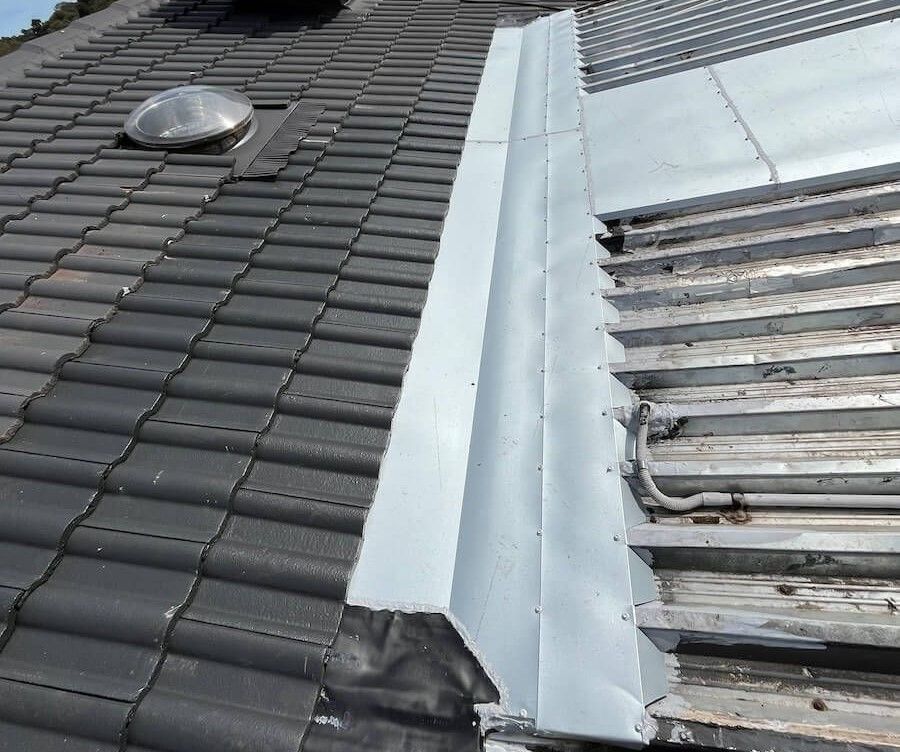What is Roof Flashing?

Most people take their roof for granted, assuming it will always do its job of keeping their home safe and dry. However, even the most durable roofing materials can develop weak points where water might seep in, leading to costly damage over time. That’s where roof flashing comes in—it’s an essential component that helps direct water away from the most vulnerable areas of your roof.
Unlike tiles, which are designed to repel water across large surfaces,
flashing works as a precision barrier, sealing the joints and intersections where water infiltration is most likely to occur. Without proper flashing, even a well-built roof can be susceptible to
leaks, rot, and structural decay.
Why is Roof Flashing Important?
Roof flashing is a thin, weather-resistant material used to direct water away from critical areas of a roof, such as joints, valleys, and chimneys, to prevent leaks and water damage. It acts as a protective barrier against water intrusion in vulnerable areas. Rainwater can seep into gaps without it, leading to leaks, structural damage, and costly repairs. Properly installed flashing ensures water is directed away from weak points, keeping the home dry and well-protected.
Beyond preventing water damage, roof flashing also plays a key role in extending the lifespan of the roof. Continuous exposure to moisture can cause timber framing to rot, insulation to deteriorate, and mould to develop, creating serious health and safety risks. By reinforcing these high-risk areas, flashing helps maintain the roof’s integrity, improves energy efficiency, and ensures compliance with Australian building codes. Regular inspections and maintenance of flashing are essential to protecting your home from long-term damage and maintaining its value.
What Materials Are Used for Roof Flashing?
In Australia, roof flashing is made from durable, weather-resistant materials designed to withstand the country's diverse climate conditions. The most commonly used materials include:
- Colorbond Steel
One of the most popular choices in Australia due to its durability, corrosion resistance, and aesthetic appeal and it’s excellent for both urban and coastal environments, as it resists rust and harsh weather. Colorbond is also available in a range of colours to match roofing materials. - Aluminium
Lightweight, flexible, and highly resistant to corrosion, making it ideal for coastal areas with high salt exposure. Aluminium sheets are easy to shape and install and are often used around chimneys, skylights, and vents. Additional coatings may be required for enhanced durability. - Copper
Copper is known for its long lifespan (50+ years) and natural corrosion resistance. Copper develops a patina over time, which actually improves its weather resistance. It’s more expensive than other options but offers superior durability and an attractive appearance. - Lead
Traditionally used for highly flexible and long-lasting flashing, and is resistant to extreme weather conditions, UV rays, and thermal expansion. Due to environmental concerns, lead flashing is becoming less common in modern Australian homes.
Choosing the Right Flashing Material
The best flashing material depends on factors such as:
- Climate conditions (e.g., coastal vs. inland areas)
- Roofing material compatibility
- Budget and aesthetic preferences
- Longevity and maintenance requirements
For most Australian homes, Colorbond steel and aluminium are the preferred choices due to their resistance to corrosion, durability, and compatibility with modern roofing materials. Regular roof inspection and maintenance of flashing, regardless of material, are essential to ensure long-term protection against leaks and weather damage.
Where Is Roof Flashing Installed?
Roof flashing is strategically placed in areas where the roof is most vulnerable to water penetration. These are typically joints, intersections, and openings where different roofing materials meet or where water naturally flows. Proper flashing installation is essential to ensure a watertight seal and protect against leaks, structural damage, and mould growth. Roof flashing is installed in areas such as:
- Roof valleys
- Chimneys and skylights
- Around vents and exhaust pipes
- Along roof-to-wall intersections
- At the base of dormer windows
How do I Know if my Roof Flashing Needs to be Replaced?
Roof flashing should be inspected regularly to ensure it remains intact and effective. One of the most obvious signs that flashing needs to be replaced is visible rust, corrosion, or cracks in the material. Metal flashing can deteriorate over time, particularly in coastal areas where salt exposure accelerates corrosion.
Another key indicator is water leaks or damp spots on ceilings and walls, which suggest that flashing is no longer sealing properly. If you notice water stains, peeling paint, or mould growth inside your home, it could be due to failing flashing allowing moisture to seep in.
Loose or missing flashing is also a warning sign. Strong winds, heavy storms, or poor installation can cause flashing to shift or detach, leaving gaps where water can enter. If you see flashing that has lifted or is no longer flush against the roof, it needs to be repaired or replaced immediately.
Additionally, if your roof is over 15-20 years old, having a professional inspect the flashing during routine maintenance is a good idea. Over time, even high-quality materials can weaken due to thermal expansion and contraction, making them less effective at keeping water out. Regular inspections can help catch issues early and prevent costly repairs.
How Much Does Roof Flashing Replacement Cost in Australia?
The cost varies depending on the material and the complexity of the job, but homeowners can expect to pay anywhere from $200 to $1,500 AUD for flashing replacement, depending on the extent of the work.
What is the Best Type of Flashing for Coastal Areas in South Australia?
For homes near the coast, Colorbond or aluminium flashing is recommended due to its high resistance to saltwater corrosion. Copper is also a durable option but may develop a patina over time.
How Long Does Roof Flashing Last in Australian Conditions?
The lifespan of roof flashing depends on the material and climate. Generally:
- Colorbond and aluminium: 20–30 yearsCopper: 50+ years
- Lead: 50+ years but less commonly used
- Galvanised steel: 10–20 years (shorter lifespan in coastal areas)
Can Damaged Flashing Cause Roof Leaks?
Yes, damaged or improperly installed flashing is one of the most common causes of roof leaks. It allows water to seep into vulnerable areas, leading to costly structural damage and mould growth.
Is Flashing Required by Australian Building Codes?
Yes, the National Construction Code (NCC) and Australian Standards (AS 2050:2018 – Installation of Roof Tiles) specify flashing requirements to ensure proper waterproofing and compliance with local regulations.
Contact Done Right Roofing for best and most honest advice and roof repairs Adelaide.
Emergency Roof Repairs and Roof Inspections Adelaide? We are one call away!
Get in touch with us for all roof repairs, roof replacement and roof plumbing inspections. We serve all Adelaide suburbs.
QUICK LINKS
ROOFING SERVICES
CONTACT INFORMATION
Mobile:
0418 804 934 (24 X 7 Call Out Service)
Email: donerightSA@gmail.com
Builders License: 255839
Roof Plumbing License: BLD255839
ABN 61 079 031 054
